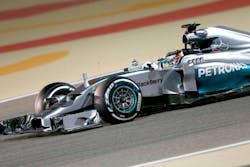Pirelli motorsport director Paul Hembery summarized 10 key tire points for 2014 between the two free practice sessions at the Bahrain Grand Prix, where the P Zero White medium and P Zero Yellow soft tires have been nominated.
1. More energy goes into the tires from sliding
Pirelli changed all the slick tire compounds and profiles this year to take into account increased wheelspin and lack of downforce. Paul Hembery: “The cars are sliding around more and that has a big effect on the tire. There’s only 5% less energy going into the tire in the new-look Formula One – but instead of it coming from lateral forces and cornering, some of that energy is now coming from sliding.”
2. Fewer marbles out on track
There are fewer marbles out on track: one of Pirelli’s key objectives. Paul Hembery: “We did see some in Malaysia, but that’s not a good example as it’s a very abrasive track. Overall, we’re very confident that we’ve made a suitable step forward in the direction of reducing marbles.”
3. Less aquaplaning and more performance from the rain tires
Pirelli changed the compounding and design of the full wet tire to improve aquaplaning performance in particular. Paul Hembery: “Firstly, we saw during qualifying in Melbourne that there is a closer crossover point with the intermediate tire, which makes it more usable. Secondly, in Malaysia there were no comments about aquaplaning, which was all we heard about last year. The new rain tire performs even better in cool temperatures: during wet weather testing in Barcelona it was three seconds a lap quicker than the previous rain tire.”
4. Decreased graining
Pirelli has used all the tires so far apart from the supersoft, with decreased graining. And even when surface graining does occur, it soon goes away. Paul Hembery: “Compared to previous seasons the graining brushed off after a few laps.”
5. Flat spots disappearing
Even though the cars are locking up more under braking, flat spots are not remaining on the surface of the tire as they used to, thanks to the new compounds. Paul Hembery: “After the drivers complete another section of corners, the flat spots wear off, whereas in the past that would have caused another tire change.”
6. Two-stop races to become normal
With so much to learn from the new cars, it was only in Malaysia that tire strategy really emerged. Paul Hembery: “Hulkenberg completed the race with just two stops as opposed to the three-stopper that we felt would be the case. With the rapid evolution of the cars we anticipate this year, we’re sure that we’ll see the vast majority of races all moving towards a two-stop strategy.”
7. Why degradation is important
Wear is the physical consumption of the tire, which has been substantially reduced this year (and why you see fewer marbles). Degradation is another thing entirely: the loss of tire performance per lap. Paul Hembery: “It’s a strange situation when drivers talk about degradation: it needs to happen as if it doesn’t, we won’t have any pit stops. It’s a parameter that is vital to create the strategy.”
8. tires less stressed than before
Despite more torque the rear tire footprint isn’t being worked as hard as it was last year – due to the updated construction. Paul Hembery: “We can see that in the wear profiles: it’s slightly concentrated in the centre of the tire. As downforce increases that will change, because the biggest improvements will come from increased downforce and traction from rear tires.”
9. Regular gaps between the compounds
Pirelli aims to have one-second gaps between all the compounds. While this is not currently the case, it is likely to be by the end of the year. Paul Hembery: “We were slightly surprised by the gap between the hard and the medium, which was one and a half seconds in Malaysia. That is down to decreased downforce levels at the start of the season: the hard tire is not worked as much as it once was, so it slides more. Improvements in performance will make that gap smaller.”
10. More cars out on track
Pirelli has supplied extra tires for FP1 and Q3 – which has meant more cars out on track. Paul Hembery: “It’s worked so far. In the first half-hour of FP1, the teams have been doing 10 or 12 laps with the extra tires but they could do a lot more. In qualifying our intention was to provide the top cars running in Q3 for the fans, without disadvantaging the others.”
Bahrain: Friday Free Practice
During FP1 and FP2 in Bahrain the gap between the medium and the soft tire was bigger than expected, with more than a second between the two compounds. There was very low wear, and some thermal degradation on the soft tire, which appears to be very stable and opens the door to some possible two-stop strategies for the race.
Paul Hembery: “Here in Bahrain we are currently seeing a performance gap of more than a second between the medium and soft compounds. However, we will have to wait until tomorrow to have a clearer idea of what the final difference will be in the race.”
FP2:
L Hamilton 1m34.325s Soft New
N Rosberg 1m34.690s Soft New
F Alonso 1m35.360s Soft New
In the P Zero Magazine
The brand new P Zero magazine, an innovation from Pirelli for this season, contains facts about the Bahrain Grand Prix and everything else that is happening in the world of Pirelli from the past, present and future. This dynamic new e-magazine, which contains video and other interactive content updated over the weekend, can be accessed via Pirelli’s website or on the following link: http://magazine.pzero.com



